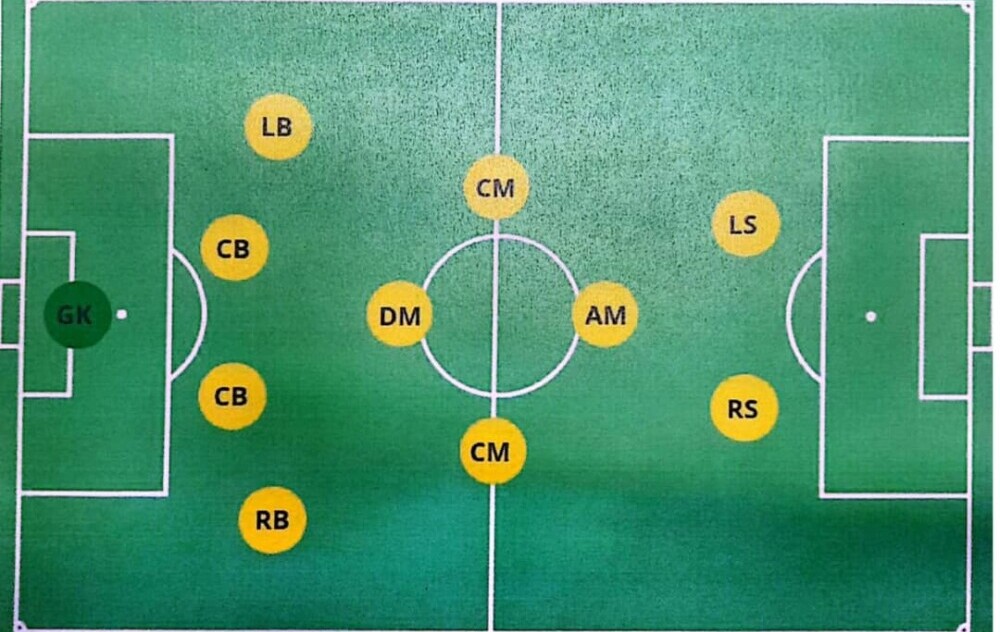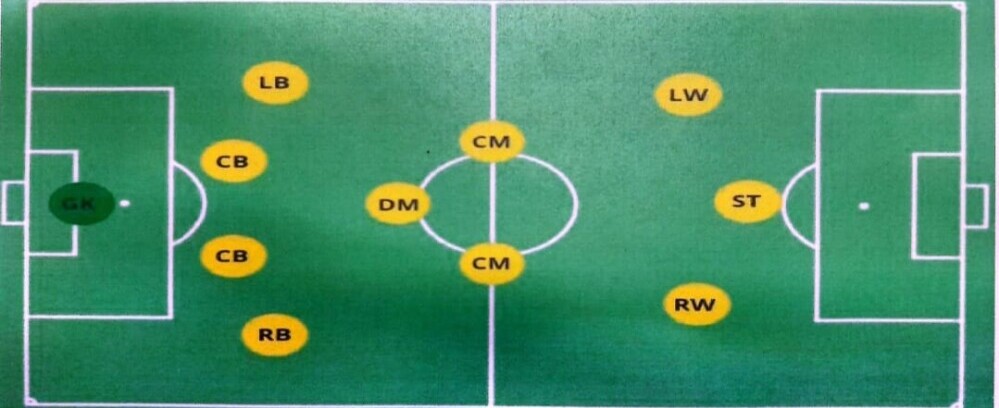Formations are like the secret sauce that adds flavor to youth soccer, providing a framework that guides players’ movements and strategies on the field.
They’re not just random placements of players; they’re planned systems that help teams operate smoothly, ensuring everyone knows where they’re supposed to be and what they’re supposed to do.
In youth soccer, understanding formations is key to developing teamwork and tactical awareness.
These alignments allow young players to grasp the importance of positioning, spacing, and roles within a game.
By learning about different formations, players start to appreciate how they can contribute to the team’s collective efforts, whether it’s pushing forward in attack or holding the line in defense.
Now, why exactly should kids bother with learning about formations?
Well, it’s simple. Formations teach discipline and cooperation.
They help young players understand that soccer isn’t just about chasing the ball around the field, but about smart, strategic play.
Players get to see how their individual effort fits into a bigger picture, making them not only better team players but smarter ones too.
Exploring formations is also a fun way for kids to build soccer IQ.
It helps them see the game differently, spotting patterns and anticipating moves. This way, kids don’t just play; they engage their brains, learning when to advance, when to hold back, and how to find the best path forward.
So, while formations might sound technical, they offer a fun and rewarding way for youth players to dive into the world of soccer.
Throughout our discussion, we’ll delve into popular formations like the classic 4-4-2 and the dynamic 4-3-3, each bringing its unique advantages and challenges.
By exploring these setups, players, coaches, and even parents can gain valuable insights into how these formations can be adapted to suit youth soccer teams, fostering both individual improvement and team success.
The 4-4-2 Formation: Balancing Attack and Defense
The 4-4-2 formation is like your favorite pair of jeans – it’s classic, straightforward, and it just works.
With this setup, teams place four defenders, four midfielders, and two strikers on the field, creating a balanced approach that covers a lot of ground.
For youth teams, the appeal of the 4-4-2 lies in its simplicity and effectiveness. It’s a great starting point for young players to understand positioning and teamwork.
This formation spreads players across the field in a way that is easy to grasp – defenders protect the back, midfielders hold the center, and strikers aim for the goal. But there’s a bit more to it than that, so let’s explore.
One major perk of the 4-4-2 is its ability to shift between attacking and defensive strategies seamlessly.
When on the attack, midfielders can push forward to provide support, creating more goal-scoring opportunities. Conversely, when defending, these midfielders drop back, adding an extra layer of defense against the opponent.
But hey, it’s not all roses.
There are some pitfalls to watch out for, particularly the predictability factor in midfield.
Opponents might exploit gaps if they’re playing a formation with more midfielders.
That’s why communication and awareness are crucial – players need to be mindful of their positioning and support each other.
Here’s a tip: encourage young players to talk on the field.
Simple cues like “press,” “cover,” or “switch” can make a ton of difference, helping the team stay organized and react faster.
Ultimately, mastering 4-4-2 isn’t just about sticking to a formation; it’s about using it as a tool to enhance spatial awareness and on-field communication.
For coaches, teaching the 4-4-2 can be a rewarding experience. Emphasize practices that focus on teamwork and ball distribution.
Drill exercises like “pass and move” or “shadow play” help kids understand the flow of the game and the importance of coordinated effort.
Through understanding and practicing this time-tested formation, youth soccer teams develop the foundational skills that pave the way for more complex strategies.
The focus here is on using the 4-4-2 as a stepping stone towards mastering the game, building confidence, and making soccer enjoyable and engaging for everyone involved.
Exploring the 4-3-3 Formation: A Blend of Versatility and Control
Ever wondered how some teams make soccer look so fluid and dynamic?
The 4-3-3 formation might have something to do with it.
With four defenders, three midfielders, and three forwards, this setup is all about balancing offense with defense while allowing for plenty of flexibility.
In youth soccer, the 4-3-3 offers a brilliant platform for players to explore different roles, especially with the midfield triangle.
This triangle consists of a defensive midfielder positioned just in front of the back four, alongside two more offensive-minded midfielders who are free to create play and back up the attack.
It’s a fantastic way for young players to learn how to control the pace and flow of the game.
What’s awesome about the 4-3-3 is how it encourages wingers to participate actively in both attacking and defending.
The presence of wide players often stretches the opposition, making space for quick plays or vital interceptions.
However, the catch is these wingers need to be swift decision-makers – moving smartly between creating chances and recovering in defense when the need arises.
The key strength of the 4-3-3 lies in its versatility.
The midfielders support both ends, making sure there’s a solid connection from back to front.
It teaches kids the importance of being adaptable, able to shift their focus based on the game situation.
But, like any strategy, it has its quirks. If the team pushes too far up without control, it might leave gaps behind, vulnerable to swift counterattacks.
That’s where practice and discipline come into play. Training exercises that emphasize coordinated movement and situational awareness can help players better manage these transitions.
To sum it up, the 4-3-3 is a slightly more advanced option for youth teams ready to take on more complex strategies.
It’s brilliant for players to develop communication, quick decision-making, and technical skills, making it a fun and challenging formation.
By nurturing these areas, teams not only get stronger but also enjoy the game on a whole new level.
Winning Plays: Techniques for Formation Precision
Whether you’re rolling with a 4-4-2 or rocking the 4-3-3, precise execution is what separates the pros from the amateurs.
Youth soccer is all about learning the basics and then taking them to the next level, and mastering passing techniques is the heart of that journey.
Let’s chat about passing accuracy—it’s a game-changer. Imagine threading the ball right through the defense or pinging it perfectly to a teammate streaking upfield.
For young players, developing confidence in their passing skills is crucial. Short passes, long balls, and everything in between help keep possession and create scoring chances.
One cool technique to explore is the ‘pass and move’ tactic often called tiki-taka. This involves quick, controlled passes—like a dance—as players shift around, always moving into open space.
It’s great for keeping the ball and wearing down the opposition. To nail this, players must work on their footwork and vision, making sure they aren’t just passing but also thinking two steps ahead.
Wing play can be another key element in executing formations effectively. When players use the full width of the field, they can stretch the defense and create more room for attacks.
Training wingers to cross accurately and make decisive runs can really spice up a team’s offense.
Then there’s the art of pressing and counterattacking. Teach your players to recognize moments when the opposition is vulnerable—usually right after they lose the ball.
Quick, coordinated pressure can win the ball back high up—and boom—create instant chances. It’s not just about chasing the ball; it’s about knowing when and where to apply pressure to make it count.
Don’t forget set pieces, too. Free kicks, corners, and penalties give teams strategic opportunities to capitalize on a dead ball situation.
Practicing these elements not only polishes individual skills but also reinforces team tactics during high-pressure moments.
So, as youth players embrace these concepts, they begin to see how formations are the framework, but it’s the play execution that makes the magic happen on the field.
Encourage constant learning, practicing with purpose, and, above all, loving the game. As skills grow, so does confidence, leading to more joy and success on the pitch.
Take away
Ready to take your youth soccer team to the next level?
Start by incorporating formation strategies and techniques into your training sessions.
Encourage player development, teamwork, and sportsmanship.
Share your passion for the game, and inspire your team to become confident, skilled, and passionate players.
Get started today!!!!!
” Here’s a little transparency: Our website contains affiliate links. This means if you click and make a purchase, we may receive a small commission. Don’t worry, there’s no extra cost to you. It’s a simple way you can support our mission to bring you quality content.”






This post is a fantastic resource for youth soccer coaches, parents, and players alike, highlighting the importance of formations in developing soccer IQ and fostering teamwork. The emphasis on formations like the classic 4-4-2 and the dynamic 4-3-3 is spot on, as these setups are fundamental to understanding the game’s structure. The explanation of how formations teach discipline, cooperation, and strategic thinking resonates well, especially for young players just beginning their soccer journey.
I appreciate how the post dives into the specific strengths and challenges of each formation. The balance and simplicity of the 4-4-2 make it an excellent starting point for young athletes, while the 4-3-3 introduces a layer of complexity that encourages adaptability and quick decision-making. These insights provide valuable direction for coaches aiming to build well-rounded teams.
Additionally, the focus on execution through passing accuracy, wing play, and pressing strategies is crucial. The inclusion of fun, practical drills like tiki-taka and situational exercises for set pieces ensures training sessions remain engaging and effective.
Overall, this post not only educates but inspires. It’s a reminder that soccer is about more than just skills—it’s about understanding the game, working together, and fostering a lifelong passion. Great job!
Thank you so much for your kind words and detailed feedback.
I truly appreciate your insights, and it’s great to hear that the post resonated with you, especially in terms of youth development and fostering a deeper understanding of the game.
You’re absolutely right—formations play a crucial role in shaping young players’ soccer IQ, discipline, and teamwork.
The 4-4-2 and 4-3-3 are such great teaching tools, and I love how you highlighted their balance between structure and adaptability.
Developing a strong foundation with passing accuracy, wing play, and pressing strategies is key to helping young athletes thrive on the field.
I’m glad you enjoyed the practical drills mentioned! Keeping training sessions fun and engaging while reinforcing tactical awareness is always the goal.
Have you had any particular success with a specific formation when coaching or watching youth teams develop?
Thanks again for your thoughtful comment—it’s always great to connect with others who share a passion for the game and its strategic side!